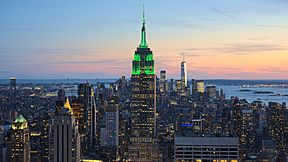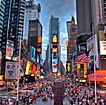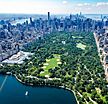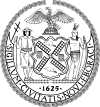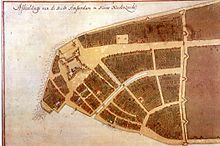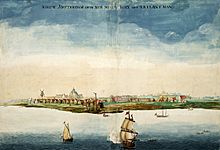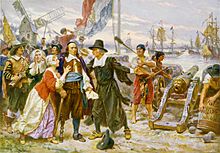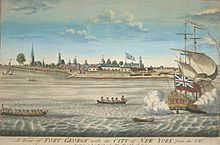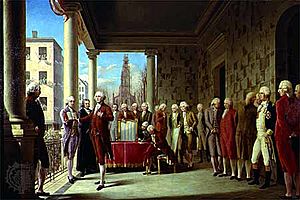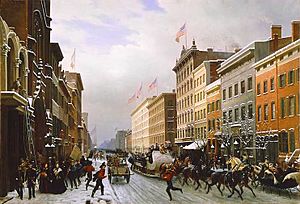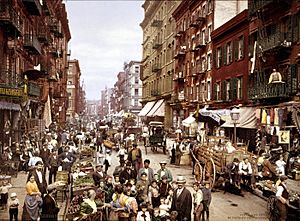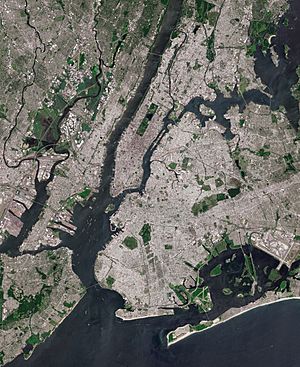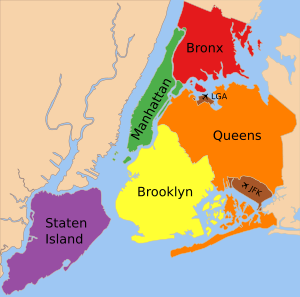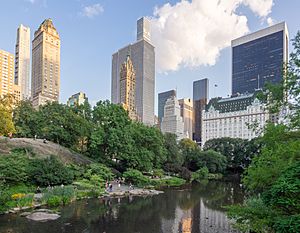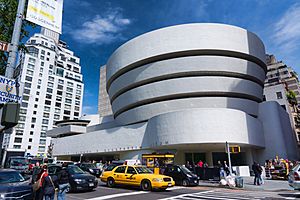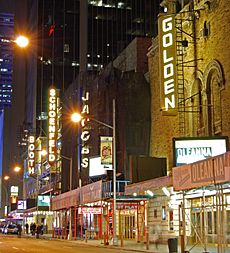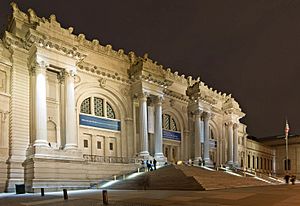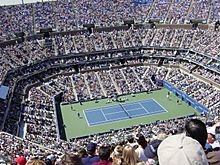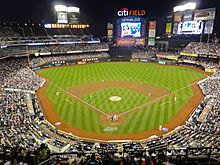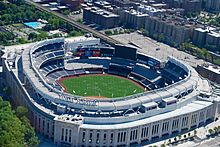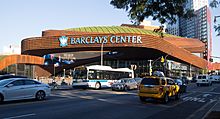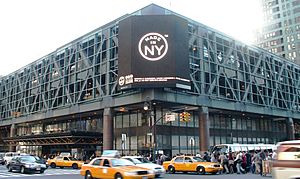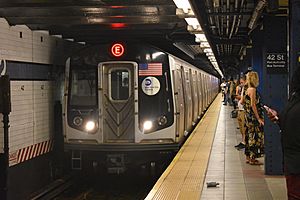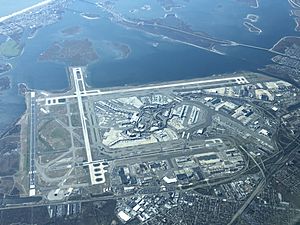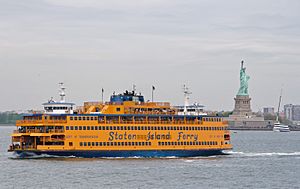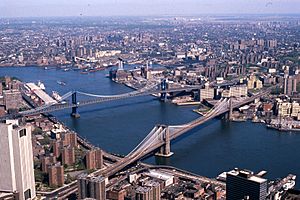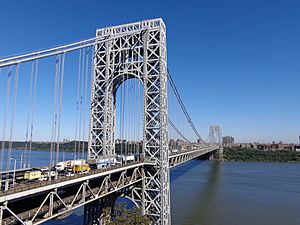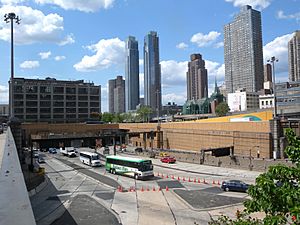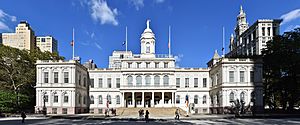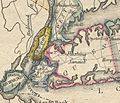New York City facts for kids
Quick facts for kids
New York
|
|||||
|---|---|---|---|---|---|
|
|||||
| Nicknames:
The Big Apple, The City That Never Sleeps, Gotham, and others
|
|||||
| Country | United States | ||||
| State | New York | ||||
| Region | Mid-Atlantic | ||||
| Constituent counties (boroughs) | Bronx (The Bronx) Kings (Brooklyn) New York (Manhattan) Queens (Queens) Richmond (Staten Island) |
||||
| Settled | 1624 | ||||
| Consolidated | 1898 | ||||
| Named for | James, Duke of York | ||||
| Government | |||||
| • Type | Strong mayor–council | ||||
| • Body | New York City Council | ||||
| Area | |||||
| • Total | 472.43 sq mi (1,223.59 km2) | ||||
| • Land | 300.46 sq mi (778.18 km2) | ||||
| • Water | 171.97 sq mi (445.41 km2) | ||||
| Highest elevation | 401 ft (122 m) | ||||
| Lowest elevation | 0 ft (0 m) | ||||
| Population
(2020)
|
|||||
| • Total | 8,804,190 | ||||
| • Estimate
(July 2022)
|
8,335,897 | ||||
| • Rank | 1st in the United States 1st in New York State |
||||
| • Density | 29,302.66/sq mi (11,313.81/km2) | ||||
| • Urban | 19,426,449 | ||||
| • Urban density | 5,980.8/sq mi (2,309.2/km2) | ||||
| • Metro | 20,140,470 | ||||
| Demonym(s) | New Yorker | ||||
| GDP | |||||
| • Total | $1.206 trillion (2022) | ||||
| • Metro | $2.163 trillion (2022) (1st) | ||||
| Time zone | UTC–05:00 (EST) | ||||
| • Summer (DST) | UTC–04:00 (EDT) | ||||
| ZIP Codes |
100xx–104xx, 11004–05, 111xx–114xx, 116xx
|
||||
| Area codes | 212/646/332, 718/347/929, 917 | ||||
| FIPS code | 36-51000 | ||||
| GNIS feature ID | 975772 | ||||
| Largest borough by area | Queens (109 sq mi or 280 km2) | ||||
| Largest borough by population | Brooklyn (2020 Census 2,736,074) | ||||
| Largest borough by GDP (2022) | Manhattan ($885.652 billion) | ||||
New York, often called New York City or simply NYC, is the most populous city in the United States located at the southern tip of New York State, on one of the world's largest natural harbors. The city comprises five boroughs: Manhattan, Brooklyn, Queens, The Bronx, and Staten Island. Home to the headquarters of the United Nations, New York is an important center for international diplomacy, and it is sometimes described as the world's most important city and the capital of the world.
Contents
History
Early history
In the pre-Columbian era, the area of present-day New York City was inhabited by Algonquians, including the Lenape. Their homeland, known as Lenapehoking, included the present-day areas of Staten Island, Manhattan, the Bronx, the western portion of Long Island (including Brooklyn and Queens), and the Lower Hudson Valley.
The first documented visit into New York Harbor by a European was in 1524 by Giovanni da Verrazzano, an explorer from Florence in the service of the French crown. He claimed the area for France and named it Nouvelle Angoulême (New Angoulême). A Spanish expedition, led by the Portuguese captain Estêvão Gomes sailing for Emperor Charles V, arrived in New York Harbor in January 1525 and charted the mouth of the Hudson River, which he named Río de San Antonio ('Saint Anthony's River').
In 1609, the English explorer Henry Hudson rediscovered New York Harbor while searching for the Northwest Passage to the Orient for the Dutch East India Company. He proceeded to sail up what the Dutch would name the North River (now the Hudson River), named first by Hudson as the Mauritius after Maurice, Prince of Orange. Hudson's first mate described the harbor as "a very good Harbour for all windes" and the river as "a mile broad" and "full of fish".
Hudson claimed the region for the Dutch East India Company. In 1614, the area between Cape Cod and Delaware Bay was claimed by the Netherlands and called Nieuw-Nederland ('New Netherland'). The first non–Native American inhabitant of what would eventually become New York City was Juan Rodriguez, a merchant from Santo Domingo who arrived in Manhattan during the winter of 1613–14, trapping for pelts and trading with the local population as a representative of the Dutch colonists.
Dutch rule
A permanent European presence near New York Harbor was established in 1624, making New York the 12th-oldest continuously occupied European-established settlement in the continental United States, with the founding of a Dutch fur trading settlement on Governors Island. In 1625, construction was started on a citadel and Fort Amsterdam, later called Nieuw Amsterdam (New Amsterdam), on present-day Manhattan Island.
The colony of New Amsterdam was centered on what would ultimately become Lower Manhattan. Its area extended from the southern tip of Manhattan to modern-day Wall Street, where a 12-foot (3.7 m) wooden stockade was built in 1653 to protect against Native American and British raids. In 1626, the Dutch colonial Director-General Peter Minuit, acting as charged by the Dutch West India Company, purchased the island of Manhattan from the Canarsie, a small Lenape band, for "the value of 60 guilders" (about $900 in 2018). A frequently told but disproved legend claims that Manhattan was purchased for $24 worth of glass beads.
Following the purchase, New Amsterdam grew slowly. To attract settlers, the Dutch instituted the patroon system in 1628, whereby wealthy Dutchmen (patroons, or patrons) who brought 50 colonists to New Netherland would be awarded swaths of land, along with local political autonomy and rights to participate in the lucrative fur trade. This program had little success.
Since 1621, the Dutch West India Company had operated as a monopoly in New Netherland, on authority granted by the Dutch States General. In 1639–1640, in an effort to bolster economic growth, the Dutch West India Company relinquished its monopoly over the fur trade, leading to growth in the production and trade of food, timber, tobacco, and slaves (particularly with the Dutch West Indies).
In 1647, Peter Stuyvesant began his tenure as the last Director-General of New Netherland. During his tenure, the population of New Netherland grew from 2,000 to 8,000. Stuyvesant has been credited with improving law and order in the colony; however, he earned a reputation as a despotic leader. He instituted regulations on liquor sales, attempted to assert control over the Dutch Reformed Church, and blocked other religious groups (including Quakers, Jews, and Lutherans) from establishing houses of worship. The Dutch West India Company would eventually attempt to ease tensions between Stuyvesant and residents of New Amsterdam.
English rule
In 1664, unable to summon any significant resistance, Stuyvesant surrendered New Amsterdam to English troops, led by Colonel Richard Nicolls, without bloodshed. The terms of the surrender permitted Dutch residents to remain in the colony and allowed for religious freedom.
In 1667, during negotiations leading to the Treaty of Breda after the Second Anglo-Dutch War, the victorious Dutch decided to keep the nascent plantation colony of what is now Suriname on the northern South American coast, which they had gained from the English; and in return, the English kept New Amsterdam. The fledgling settlement was promptly renamed "New York" after the Duke of York (the future King James II and VII). After the founding, the duke gave part of the colony to proprietors George Carteret and John Berkeley. Fort Orange, 150 miles (240 km) north on the Hudson River, was renamed Albany after James's Scottish title.
On August 24, 1673, during the Third Anglo-Dutch War, Anthony Colve of the Dutch navy seized New York from the English at the behest of Cornelis Evertsen the Youngest and rechristened it "New Orange" after William III, the Prince of Orange. The Dutch would soon return the island to England under the Treaty of Westminster of November 1674.
Several intertribal wars among the Native Americans and some epidemics brought on by contact with the Europeans caused sizeable population losses for the Lenape between the years 1660 and 1670. By 1700, the Lenape population had diminished to 200. New York experienced several yellow fever epidemics in the 18th century, losing ten percent of its population in 1702 alone.
In the early 18th century, New York grew in importance as a trading port while as a part of the colony of New York. It became a center of slavery, with 42% of households enslaving Africans by 1730. Most cases were that of domestic slavery; others were hired out to work at labor. Slavery became integrally tied to New York's economy through the labor of slaves throughout the port, and the banking and shipping industries trading with the American South. During construction in Foley Square in the 1990s, the African Burying Ground was discovered; the cemetery included 10,000 to 20,000 of graves of colonial-era Africans, some enslaved and some free.
The 1735 trial and acquittal in Manhattan of John Peter Zenger, who had been accused of seditious libel after criticizing colonial governor William Cosby, helped to establish freedom of the press in North America. In 1754, Columbia University was founded under charter by King George II as King's College in Lower Manhattan.
American Revolution
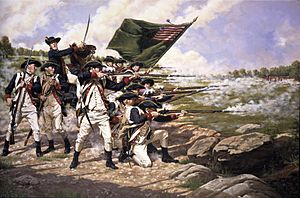
The Stamp Act Congress met in New York in October 1765, as the Sons of Liberty organization emerged in the city and skirmished over the next ten years with British troops stationed there. The Battle of Long Island, the largest battle of the American Revolutionary War, was fought in August 1776 within the modern-day borough of Brooklyn. A British rout of the Continental Army at the Battle of Fort Washington in November 1776 eliminated the last American stronghold in Manhattan, forcing George Washington and his forces in retreat across the Hudson River to New Jersey, pursued by British forces.
After the battle, in which the Americans were defeated, the British made the city their military and political base of operations in North America. The city was a haven for Loyalist refugees and escaped slaves who joined the British lines for freedom newly promised by the Crown, with as many as 10,000 escaped slaves crowded into the city during the British occupation, which had become the largest such community on the continent. When the British forces evacuated New York at the close of the war in 1783, they transported thousands of freedmen for resettlement in Nova Scotia, England, and the Caribbean.
The attempt at a peaceful solution to the war took place at the Conference House on Staten Island between American delegates, including Benjamin Franklin, and British general Lord Howe on September 11, 1776. Shortly after the British occupation began, the Great Fire of New York occurred, a large conflagration on the West Side of Lower Manhattan, which destroyed nearly 500 buildings, about a quarter of the structures in the city, including Trinity Church.
Post-revolutionary period and early 19th century
In January 1785, the assembly of the Congress of the Confederation made New York City the national capital, shortly after the war. New York was the last capital of the U.S. under the Articles of Confederation and the first capital under the Constitution of the United States. As the U.S. capital, New York City hosted several events of national scope in 1789—the first President of the United States, George Washington, was inaugurated; the first United States Congress and the Supreme Court of the United States each assembled for the first time; and the United States Bill of Rights was drafted, all at Federal Hall on Wall Street.
In 1790, for the first time, New York City, surpassed Philadelphia as the nation's largest city. At the end of 1790, the national capital was moved to Philadelphia.
Over the nineteenth century, New York City's population grew from 60,000 to 3.43 million. Under New York State's abolition act of 1799, children of slave mothers were to be eventually liberated but to be held in indentured servitude until their mid-to-late twenties. Together with slaves freed by their masters after the Revolutionary War and escaped slaves, a significant free-Black population gradually developed in Manhattan. Under such influential United States founders as Alexander Hamilton and John Jay, the New York Manumission Society worked for abolition and established the African Free School to educate Black children. It was not until 1827 that slavery was completely abolished in the state, and free Blacks struggled afterward with discrimination. New York interracial abolitionist activism continued; among its leaders were graduates of the African Free School. New York city's population jumped from 123,706 in 1820 to 312,710 by 1840, 16,000 of whom were Black.
In the 19th century, the city was transformed by both commercial and residential development relating to its status as a national and international trading center, as well as by European immigration, respectively. The city adopted the Commissioners' Plan of 1811, which expanded the city street grid to encompass almost all of Manhattan. The 1825 completion of the Erie Canal through central New York connected the Atlantic port to the agricultural markets and commodities of the North American interior via the Hudson River and the Great Lakes. Local politics became dominated by Tammany Hall, a political machine supported by Irish and German immigrants.
Several prominent American literary figures lived in New York during the 1830s and 1840s, including William Cullen Bryant, Washington Irving, Herman Melville, Rufus Wilmot Griswold, John Keese, Nathaniel Parker Willis, and Edgar Allan Poe. Public-minded members of the contemporaneous business elite lobbied for the establishment of Central Park, which in 1857 became the first landscaped park in an American city. and one of the most filmed and visited locations in the world, with 40 million visitors in 2013.
The Great Irish Famine brought a large influx of Irish immigrants, of whom more than 200,000 were living in New York by 1860, representing upward of one-quarter of the city's population. There was also extensive immigration from the German provinces, where revolutions had disrupted societies, and Germans comprised another 25% of New York's population by 1860.
American Civil War
Democratic Party candidates were consistently elected to local office, increasing the city's ties to the South and its dominant party. In 1861, Mayor Fernando Wood called on the aldermen to declare independence from Albany and the United States after the South seceded, but his proposal was not acted on. Anger at new military conscription laws during the American Civil War (1861–1865), which spared wealthier men who could afford to hire a substitute, led to the Draft Riots of 1863, whose most visible participants were ethnic Irish working class.
The draft riots deteriorated into attacks on New York's elite, followed by attacks on Black New Yorkers and their property after fierce competition for a decade between Irish immigrants and Black people for work. Rioters burned the Colored Orphan Asylum to the ground. At least 120 people were killed. The Black population in Manhattan fell below 10,000 by 1865.
Late 19th and early 20th century
In 1886, the Statue of Liberty, a gift from France, was dedicated in New York Harbor. The statue welcomed 14 million immigrants as they came to the U.S. via Ellis Island by ship in the late 19th and early 20th centuries, and is a symbol of the United States and American ideals of liberty and peace.
In 1898, the City of New York was formed with the consolidation of Brooklyn (until then a separate city), the County of New York (which then included parts of the Bronx), the County of Richmond, and the western portion of the County of Queens. The opening of the subway in 1904, first built as separate private systems, helped bind the new city together. Throughout the first half of the 20th century, the city became a world center for industry, commerce, and communication.
In 1904, the steamship General Slocum caught fire in the East River, killing 1,021 people on board. In 1911, the Triangle Shirtwaist Factory fire, the city's worst industrial disaster, killed 146 garment workers and spurred the growth of the International Ladies' Garment Workers' Union and major improvements in factory safety standards.
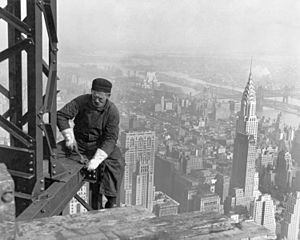
New York's non-White population was 36,620 in 1890. New York City was a prime destination in the early twentieth century for African Americans during the Great Migration from the American South, and by 1916, New York City had become home to the largest urban African diaspora in North America. The Harlem Renaissance of literary and cultural life flourished during the era of Prohibition. The larger economic boom generated construction of skyscrapers competing in height and creating an identifiable skyline.
New York City became the most populous urbanized area in the world in the early 1920s, overtaking London. The metropolitan area surpassed the 10 million mark in the early 1930s, becoming the first megacity in human history. The Great Depression saw the election of reformer Fiorello La Guardia as mayor and the fall of Tammany Hall after eighty years of political dominance.
Returning World War II veterans created a post-war economic boom and the development of large housing tracts in eastern Queens and Nassau County. New York emerged from the war unscathed as the leading city of the world, with Wall Street leading America's place as the world's dominant economic power. The United Nations headquarters was completed in 1952, solidifying New York's global geopolitical influence, and the rise of abstract expressionism in the city precipitated New York's displacement of Paris as the center of the art world.
Geography
New York City is situated in the northeastern United States, in southeastern New York State, approximately halfway between Washington, D.C. and Boston. Its location at the mouth of the Hudson River, which feeds into a naturally sheltered harbor and then into the Atlantic Ocean, has helped the city grow in significance as a trading port. Most of the city is built on the three islands of Long Island, Manhattan, and Staten Island.
During the Wisconsin glaciation, 75,000 to 11,000 years ago, the New York City area was situated at the edge of a large ice sheet. The erosive forward movement of the ice (and its subsequent retreat) contributed to the separation of what is now Long Island and Staten Island. That action left bedrock at a relatively shallow depth, providing a solid foundation for most of Manhattan's skyscrapers.
The Hudson River flows through the Hudson Valley into New York Bay. Between New York City and Troy, New York, the river is an estuary. The Hudson River separates the city from the U.S. state of New Jersey. The East River—a tidal strait—flows from Long Island Sound and separates the Bronx and Manhattan from Long Island. The Harlem River, another tidal strait between the East and Hudson rivers, separates most of Manhattan from the Bronx. The Bronx River, which flows through the Bronx and Westchester County, is the only entirely freshwater river in the city.
The city's land has been altered substantially by human intervention, with considerable land reclamation along the waterfronts since Dutch colonial times; reclamation is most prominent in Lower Manhattan, with developments such as Battery Park City in the 1970s and 1980s. Some of the natural relief in topography has been evened out, especially in Manhattan.
The city's total area is 468.484 square miles (1,213.37 km2). 302.643 sq mi (783.84 km2) of the city is land and 165.841 sq mi (429.53 km2) of is water. The highest point in the city is Todt Hill on Staten Island, which, at 409.8 feet (124.9 m) above sea level, is the highest point on the eastern seaboard south of Maine. The summit of the ridge is mostly covered in woodlands as part of the Staten Island Greenbelt.
Boroughs
- Manhattan (New York County) is the geographically smallest and most densely populated borough. It is home to Central Park and most of the city's skyscrapers, and is sometimes locally known as The City. Manhattan's population density of 70,450.8 inhabitants per square mile (27,201.2/km2) in 2022 makes it the highest of any county in the United States and higher than the density of any individual American city. Manhattan is the cultural, administrative, and financial center of New York City and contains the headquarters of many major multinational corporations, the United Nations headquarters, Wall Street, and a number of important universities. The borough is often described as the financial and cultural center of the world.
- Brooklyn (Kings County), on the western tip of Long Island, is the city's most populous borough. Brooklyn is known for its cultural, social, and ethnic diversity, an independent art scene, distinct neighborhoods, and a distinctive architectural heritage. Downtown Brooklyn is the largest central core neighborhood in the Outer Boroughs. The borough has a long beachfront shoreline including Coney Island, established in the 1870s as one of the earliest amusement grounds in the U.S. Marine Park and Prospect Park are the two largest parks in Brooklyn. Since 2010, Brooklyn has evolved into a thriving hub of entrepreneurship and high technology startup firms, and of postmodern art and design. Brooklyn is also home to Fort Hamilton, the U.S. military's only active duty installation within New York City, aside from Coast Guard operations. The facility was established in 1825 on the site of a battery used during the American Revolution, and it is one of America's longest serving military forts.
- Queens (Queens County), on Long Island north and east of Brooklyn, is geographically the largest borough, the most ethnically diverse county in the United States, and the most ethnically diverse urban area in the world. Queens is the site of the Citi Field baseball stadium, home of the New York Mets, and hosts the annual U.S. Open tennis tournament at Flushing Meadows–Corona Park. Additionally, two of the three busiest airports serving the New York metropolitan area, John F. Kennedy International Airport and LaGuardia Airport, are in Queens.
- The Bronx (Bronx County) is both New York City's northernmost borough, and the only one that is mostly on the mainland. It is the location of Yankee Stadium, the baseball park of the New York Yankees, and home to the largest cooperatively-owned housing complex in the United States, Co-op City. It is home to the Bronx Zoo, the world's largest metropolitan zoo, which spans 265 acres (1.07 km2) and houses more than 6,000 animals. The Bronx is the birthplace of hip hop music and its associated culture. Pelham Bay Park is the largest park in New York City, at 2,772 acres (1,122 ha).
- Staten Island (Richmond County) is the most suburban in character of the five boroughs. It is connected to Brooklyn by the Verrazzano-Narrows Bridge, and to Manhattan by way of the free Staten Island Ferry. In central Staten Island, the Staten Island Greenbelt spans approximately 2,500 acres (10 km2), including 28 miles (45 km) of walking trails and one of the last undisturbed forests in the city. Designated in 1984 to protect the island's natural lands, the Greenbelt comprises seven city parks.
Climate
New York City has a humid subtropical climate. The city receives 49.5 inches (1,260 mm) of precipitation annually, which is relatively evenly spread throughout the year. New York averages over 2,500 hours of sunshine annually.
Winters are chilly and damp. The daily mean temperature in January, the area's coldest month, is 33.3 °F (0.7 °C). Spring and autumn are unpredictable and can range from cool to warm, although they are usually mild with low humidity. Summers are typically hot and humid, with a daily mean temperature of 77.5 °F (25.3 °C) in July.
Hurricanes and tropical storms are rare in the New York area.
Parks
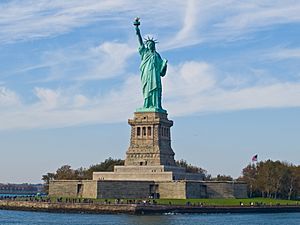
The city of New York has a complex park system, with various lands operated by the National Park Service, the New York State Office of Parks, Recreation and Historic Preservation, and the New York City Department of Parks and Recreation. In its 2018 ParkScore ranking, the Trust for Public Land reported that the park system in New York City was the ninth-best park system among the fifty most populous U.S. cities.
Gateway National Recreation Area contains over 26,000 acres (110 km2), most of it in New York City. In Brooklyn and Queens, the park contains over 9,000 acres (36 km2) of salt marsh, wetlands, islands, and water, including most of Jamaica Bay and the Jamaica Bay Wildlife Refuge. Also in Queens, the park includes a significant portion of the western Rockaway Peninsula, most notably Jacob Riis Park and Fort Tilden. In Staten Island, it includes Fort Wadsworth, with historic pre-Civil War era Battery Weed and Fort Tompkins, and Great Kills Park.
The Statue of Liberty National Monument and Ellis Island Immigration Museum are managed by the National Park Service and are in both New York and New Jersey. They are joined in the harbor by Governors Island National Monument. Historic sites under federal management on Manhattan Island include Stonewall National Monument; Castle Clinton National Monument; Federal Hall National Memorial; Theodore Roosevelt Birthplace National Historic Site; General Grant National Memorial (Grant's Tomb); African Burial Ground National Monument; and Hamilton Grange National Memorial. Hundreds of properties are listed on the National Register of Historic Places or as a National Historic Landmark.
There are seven state parks within the confines of New York City. They include: The Clay Pit Ponds State Park Preserve, a natural area that includes extensive riding trails; the Riverbank State Park, a 28-acre (11 ha) facility; and the Marsha P. Johnson State Park, a state park in Brooklyn and Manhattan that borders the East River renamed in honor of Marsha P. Johnson
New York City has over 28,000 acres (110 km2) of municipal parkland and 14 miles (23 km) of public beaches. The largest municipal park in the city is Pelham Bay Park in the Bronx, with 2,772 acres (1,122 ha), and the most visited urban park is the Central Park, and one of the most filmed and visited locations in the world, with 40 million visitors in 2013.
Demographics
| Historical population | ||
|---|---|---|
| Year | Pop. | ±% |
| 1698 | 4,937 | — |
| 1712 | 5,840 | +18.3% |
| 1723 | 7,248 | +24.1% |
| 1737 | 10,664 | +47.1% |
| 1746 | 11,717 | +9.9% |
| 1756 | 13,046 | +11.3% |
| 1771 | 21,863 | +67.6% |
| 1790 | 33,131 | +51.5% |
| 1800 | 60,515 | +82.7% |
| 1810 | 96,373 | +59.3% |
| 1820 | 123,706 | +28.4% |
| 1830 | 202,589 | +63.8% |
| 1840 | 312,710 | +54.4% |
| 1850 | 515,547 | +64.9% |
| 1860 | 813,669 | +57.8% |
| 1870 | 942,292 | +15.8% |
| 1880 | 1,206,299 | +28.0% |
| 1890 | 1,515,301 | +25.6% |
| 1900 | 3,437,202 | +126.8% |
| 1910 | 4,766,883 | +38.7% |
| 1920 | 5,620,048 | +17.9% |
| 1930 | 6,930,446 | +23.3% |
| 1940 | 7,454,995 | +7.6% |
| 1950 | 7,891,957 | +5.9% |
| 1960 | 7,781,984 | −1.4% |
| 1970 | 7,894,862 | +1.5% |
| 1980 | 7,071,639 | −10.4% |
| 1990 | 7,322,564 | +3.5% |
| 2000 | 8,008,288 | +9.4% |
| 2010 | 8,175,133 | +2.1% |
| 2020 | 8,804,190 | +7.7% |
| 2022 est. | 8,335,897 | −5.3% |
New York City is the most populous city in the United States, with 8,804,190 residents.
Wall Street
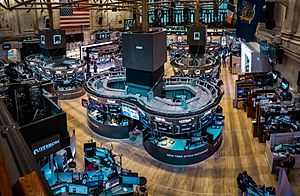
New York City's most important economic sector lies in its role as the headquarters for the U.S. financial industry, metonymously known as Wall Street. Lower Manhattan is home to the New York Stock Exchange, at 11 Wall Street, and the Nasdaq, at 165 Broadway, representing the world's largest and second largest stock exchanges, respectively.
Tourism
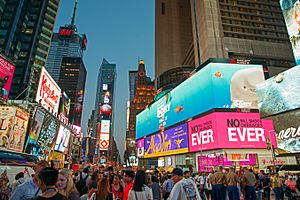
Tourism is a vital industry for New York City, and NYC & Company represents the city's official bureau of tourism. New York has witnessed a growing combined volume of international and domestic tourists, reflecting over 60 million visitors to the city per year, the world's busiest tourist destination. Approximately 12 million visitors to New York City have been from outside the United States, with the highest numbers from the United Kingdom, Canada, Brazil, and China. Multiple sources have called New York the most photographed city in the world. I Love New York (stylized I ❤ NY) is both a logo and a song that are the basis of an advertising campaign and have been used since 1977 to promote tourism in New York City, and later to promote New York State as well. The trademarked logo is owned by New York State Empire State Development.
Many districts and monuments in New York City are major landmarks, including three of the world's ten-most-visited tourist attractions in 2023. A record 66.6 million tourists visited New York City in 2019, bringing in $47.4 billion in tourism revenue. Visitor numbers dropped by two-thirds in 2020 during the pandemic, rebounding to 63.3 million in 2023. Major landmarks in New York City include the Metropolitan Museum of Art, the Statue of Liberty, the Empire State Building, and Central Park. Times Square is the brightly illuminated hub of the Broadway Theater District, one of the world's busiest pedestrian intersections, and a major center of the world's entertainment industry.
Culture
New York City is frequently the setting for novels, movies, and television programs and has been described as the cultural capital of the world. In describing New York, author Tom Wolfe said, "Culture just seems to be in the air, like part of the weather."
The city is the birthplace of many cultural movements, including the Harlem Renaissance in literature and visual art; abstract expressionism (known as the New York School) in painting; and hip-hop, punk, hardcore, salsa, freestyle, Tin Pan Alley, certain forms of jazz, and (along with Philadelphia) disco in music. New York City has been considered the dance capital of the world.
One of the most common traits attributed to New York City is its fast pace, which spawned the term New York minute. Journalist Walt Whitman characterized New York's streets as being traversed by "hurrying, feverish, electric crowds". New York City's residents are prominently known for their resilience historically, and more recently related to their management of the impacts of the 9/11 terrorist attacks and the COVID-19 pandemic. New York was voted the world's most resilient city in 2021 and 2022 per Time Out's global poll of urban residents.
Theater
The central hub of the American theater scene is Manhattan, with its divisions of Broadway, off-Broadway, and off-off-Broadway. Many movie and television stars have gotten their big break working in New York productions.
Broadway theatre is one of the premier forms of English-language theatre in the world, named after Broadway, the major thoroughfare that crosses Times Square, sometimes referred to as "The Great White Way".
Forty-one venues in Midtown Manhattan's Theatre District, each with at least 500 seats, are classified as Broadway theatres. According to The Broadway League, Broadway shows sold approximately $1.27 billion worth of tickets in the 2013–2014 season, an 11.4% increase from $1.139 billion in the 2012–2013 season. Attendance in 2013–2014 stood at 12.21 million, representing a 5.5% increase from the 2012–2013 season's 11.57 million.
The Tony Awards recognizes excellence in live Broadway theatre and are presented at an annual ceremony in Manhattan. The awards are given for Broadway productions and performances. One is also given for regional theatre. Several discretionary non-competitive awards are given as well, including a Special Tony Award, the Tony Honors for Excellence in Theatre, and the Isabelle Stevenson Award.
Architecture
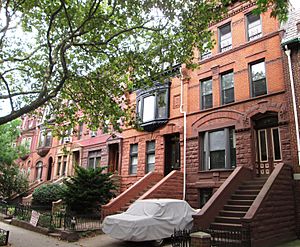
New York has architecturally noteworthy buildings in a wide range of styles and from distinct time periods, from the Dutch Colonial Pieter Claesen Wyckoff House in Brooklyn, the oldest section of which dates to 1656, to the modern One World Trade Center, the skyscraper at Ground Zero in Lower Manhattan and the most expensive office tower in the world by construction cost.
Manhattan's skyline, with its many skyscrapers, is universally recognized, and the city has been home to several of the tallest buildings in the world. As of 2019[update], New York City had 6,455 high-rise buildings, the third most in the world after Hong Kong and Seoul.
The character of New York's large residential districts is often defined by the elegant brownstone rowhouses and townhouses and shabby tenements that were built during a period of rapid expansion from 1870 to 1930. Stone and brick became the city's building materials of choice after the construction of wood-frame houses was limited in the aftermath of the Great Fire of 1835.
In contrast, New York City also has neighborhoods that are less densely populated and feature free-standing dwellings. In neighborhoods such as Riverdale (in the Bronx), Ditmas Park (in Brooklyn), and Douglaston (in Queens), large single-family homes are common in various architectural styles such as Tudor Revival and Victorian.
Arts
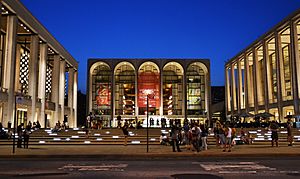
Lincoln Center for the Performing Arts, anchoring Lincoln Square on the Upper West Side of Manhattan, is home to numerous influential arts organizations, including the Metropolitan Opera, New York City Opera, New York Philharmonic, and New York City Ballet, as well as the Vivian Beaumont Theater, the Juilliard School, Jazz at Lincoln Center, and Alice Tully Hall. The Lee Strasberg Theatre and Film Institute is in Union Square, and Tisch School of the Arts is based at New York University, while Central Park SummerStage presents free music concerts in Central Park.
New York City has more than 2,000 arts and cultural organizations and more than 500 art galleries. The city government funds the arts with a larger annual budget than the National Endowment for the Arts. The city is also home to hundreds of cultural institutions and historic sites. Museum Mile is the name for a section of Fifth Avenue running from 82nd to 105th streets on the Upper East Side of Manhattan, in the upper portion of Carnegie Hill.
Nine museums occupy the length of this section of Fifth Avenue, making it one of the densest displays of culture in the world. Its art museums include the Guggenheim, Metropolitan Museum of Art, Neue Galerie New York, and The Africa Center. In addition to other programming, the museums collaborate for the annual Museum Mile Festival, held each year in June, to promote the museums and increase visitation. Many of the world's most lucrative art auctions are held in New York City.
The Metropolitan Museum of Art is the largest art museum in the Americas. In 2022 it welcomed 3,208,832 visitors, ranking it the third most visited U.S museum, and eighth on the list of most-visited art museums in the world. Its permanent collection contains over two million works, divided among 17 curatorial departments, and includes works of art from classical antiquity and ancient Egypt; paintings and sculptures from nearly all the European masters; and an extensive collection of American and modern art. The Met maintains extensive holdings of African, Asian, Oceanian, Byzantine, and Islamic art.
Cuisine
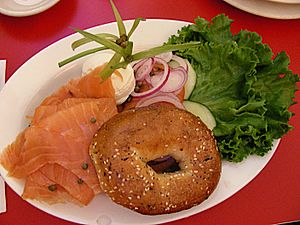
New York City's food culture includes an array of international cuisines influenced by the city's immigrant history. Central and Eastern European immigrants, especially Jewish immigrants from those regions, brought New York-style bagels, cheesecake, hot dogs, knishes, and delicatessens (delis) to the city. Italian immigrants brought New York-style pizza and Italian cuisine into the city, while Jewish immigrants and Irish immigrants brought pastrami and corned beef, respectively. Chinese and other Asian restaurants, sandwich joints, trattorias, diners, and coffeehouses are ubiquitous throughout the city. Some 4,000 mobile food vendors licensed by the city, many immigrant-owned, have made Middle Eastern foods such as falafel and kebabs examples of modern New York street food. The city is home to "nearly one thousand of the finest and most diverse haute cuisine restaurants in the world", according to Michelin. The New York City Department of Health and Mental Hygiene assigns letter grades to the city's restaurants based on inspection results. As of 2019, there were 27,043 restaurants in the city, up from 24,865 in 2017. The Queens Night Market in Flushing Meadows–Corona Park attracts more than ten thousand people nightly to sample food from more than 85 countries.
Sports
New York City is home to the headquarters of the National Football League, Major League Baseball, the National Basketball Association, the National Hockey League, and Major League Soccer.
The city is represented in the National Football League by the New York Giants and the New York Jets.
The city's two Major League Baseball teams are the New York Mets, who play at Citi Field in Queens, and the New York Yankees, who play at Yankee Stadium in the Bronx.
The city's National Basketball Association teams are the Brooklyn Nets (previously known as the New York Nets and New Jersey Nets as they moved around the metropolitan area) and the New York Knicks, while the New York Liberty is the city's Women's National Basketball Association team. The first national college-level basketball championship, the National Invitation Tournament, was held in New York in 1938 and remains in the city.
The metropolitan area is home to three National Hockey League teams. The New York Rangers, one of the league's Original Six, play at Madison Square Garden in Manhattan. The New York Islanders, traditionally representing Long Island, play in UBS Arena in Elmont, New York, but played in Brooklyn's Barclays Center from 2015 to 2020. The New Jersey Devils play at Prudential Center in nearby Newark, New Jersey.
In soccer, New York City is represented by New York City FC of Major League Soccer, who play their home games at Yankee Stadium and the New York Red Bulls, who play their home games at Red Bull Arena in nearby Harrison, New Jersey. NJ/NY Gotham FC plays their home games in Red Bull Arena, representing the metropolitan area in the National Women's Soccer League. A new version of the New York Cosmos was formed in 2010, and most recently played in the third-division National Independent Soccer Association before going on hiatus in January 2021. New York was a host city for the 1994 FIFA World Cup and will be one of eleven US host cities for the 2026 FIFA World Cup.
The annual United States Open Tennis Championships is one of the world's four Grand Slam tennis tournaments and is held at the National Tennis Center in Flushing Meadows–Corona Park, Queens. The Millrose Games is an annual track and field meet whose featured event is the Wanamaker Mile. Boxing is a prominent part of the city's sporting scene, with events like the Amateur Boxing Golden Gloves being held at Madison Square Garden each year.
Transportation
Rapid transit
Buses
New York City's public bus fleet runs 24/7 and is the largest in North America. The Port Authority Bus Terminal is the city's main intercity bus terminal and the world's busiest bus station, serving 250,000 passengers on 7,000 buses each workday in a building opened in 1950 that was designed to accommodate 60,000 daily passengers. A 2021 plan announced by the Port Authority would spend $10 billion to expand capacity and modernize the facility.
Rail
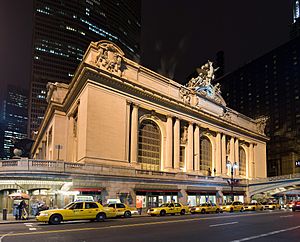
The New York City Subway system is the largest rapid transit system in the world when measured by stations in operation, with 472, and by length of routes. Nearly all of New York's subway system is open 24 hours a day, in contrast to the overnight shutdown common to systems in most cities. The New York City Subway is the busiest metropolitan rail transit system in the Western Hemisphere, with 1.70 billion passenger rides in 2019, while Grand Central Terminal, referred to as "Grand Central Station", is the world's largest railway station by number of train platforms.
New York City's commuter rail network is the largest in North America. The rail network, connecting New York City to its suburbs, consists of the Long Island Rail Road, Metro-North Railroad, and New Jersey Transit. The combined systems converge at Grand Central Terminal and Pennsylvania Station and contain more than 250 stations and 20 rail lines. For 24 hours a day, the elevated AirTrain system in Queens connects JFK International Airport to the New York City Subway and the Long Island Rail Road; a separate AirTrain system is planned alongside the Grand Central Parkway to connect LaGuardia Airport to these transit systems. For inter-city rail, New York City is served by Amtrak, whose busiest station by a significant margin is New York Penn Station on the West Side of Manhattan, from which Amtrak provides connections to Boston, Philadelphia, and Washington, D.C. along the Northeast Corridor, and long-distance train service to other North American cities.
The Staten Island Railway rapid transit system solely serves Staten Island, operating 24 hours a day. The Port Authority Trans-Hudson (PATH train) links Midtown and Lower Manhattan to northeastern New Jersey. Like the New York City Subway, the PATH operates 24 hours a day; meaning three of the six rapid transit systems in the world which operate on 24-hour schedules are wholly or partly in New York (the others are a portion of the Chicago "L", the PATCO Speedline serving Philadelphia, and the Copenhagen Metro).
Multibillion-dollar heavy rail transit projects under construction in New York City include the Second Avenue Subway.
Air
New York's airspace is the busiest in the United States and one of the world's busiest air transportation corridors. The three busiest airports in the New York metropolitan area include John F. Kennedy International Airport, Newark Liberty International Airport, and LaGuardia Airport; 130.5 million travelers used these three airports in 2016. JFK and Newark Liberty were the busiest and fourth busiest U.S. gateways for international air passengers, respectively, in 2012; as of 2011[update], JFK was the busiest airport for international passengers in North America.
Plans have advanced to expand passenger volume at a fourth airport, Stewart International Airport near Newburgh, New York, by the Port Authority of New York and New Jersey. Plans were announced in July 2015 to entirely rebuild LaGuardia Airport in a multibillion-dollar project to replace its aging facilities. Other commercial airports in or serving the New York metropolitan area include Long Island MacArthur Airport, Trenton–Mercer Airport and Westchester County Airport. The primary general aviation airport serving the area is Teterboro Airport.
Ferries, taxis and trams
The Staten Island Ferry is the world's busiest ferry route, carrying more than 23 million passengers from July 2015 through June 2016 on a 5.2-mile (8.4 km) route between Staten Island and Lower Manhattan and running 24/7. Other ferry systems shuttle commuters between Manhattan and other locales within the city and the metropolitan area. NYC Ferry, a NYCEDC initiative with routes planned to travel to all five boroughs, was launched in 2017.
Other features of the city's transportation infrastructure encompass 13,587 yellow taxicabs; other vehicle for hire companies; and the Roosevelt Island Tramway, an aerial tramway that transports commuters between Roosevelt Island and Manhattan Island.
Streets and highways
Streets are also a defining feature of the city. The Commissioners' Plan of 1811 greatly influenced its physical development. New York City has an extensive web of freeways and parkways, which link the city's boroughs to each other and to North Jersey, Westchester County, Long Island, and southwestern Connecticut through bridges and tunnels. Because these highways serve millions of outer borough and suburban residents who commute into Manhattan, it is common for motorists to be stranded for hours in traffic congestion that are a daily occurrence, particularly during rush hour. Congestion pricing in New York City will go into effect in 2022 at the earliest. Unlike the rest of the United States, New York State prohibits right or left turns on red in cities with a population greater than one million, to reduce traffic collisions and increase pedestrian safety. In New York City, therefore, all turns at red lights are illegal unless a sign permitting such maneuvers is present.
Manhattan and Staten Island are primarily coterminous with islands of the same names, while Queens and Brooklyn are at the west end of the larger Long Island, and the Bronx is on New York State's mainland. Manhattan Island is linked to New York City's outer boroughs and to New Jersey by an extensive network of bridges and tunnels. The 14-lane George Washington Bridge, connecting Manhattan to New Jersey across the Hudson River, is the world's busiest motor vehicle bridge. The Verrazzano-Narrows Bridge, spanning the Narrows between Brooklyn and Staten Island, is the longest suspension bridge in the Americas and one of the world's longest. The Brooklyn Bridge, with its stone neo-Gothic suspension towers, is an icon of the city itself; opened in 1883, it was the first steel-wire suspension bridge and was the longest suspension bridge in the world until 1903. The Queensboro Bridge "was the longest cantilever span in North America" from 1909 to 1917. The Manhattan Bridge, opened in 1909, "is considered to be the forerunner of modern suspension bridges", and its design "served as the model for the major long-span suspension bridges" of the early 20th century. The Throgs Neck Bridge and Whitestone Bridge connect Queens and the Bronx, while the Triborough Bridge connects the three boroughs of Manhattan, Queens, and the Bronx.
The Lincoln Tunnel, which carries 120,000 vehicles a day under the Hudson River between New Jersey and Midtown Manhattan, is the busiest vehicular tunnel in the world. The tunnel was built instead of a bridge to allow unfettered passage of large passenger and cargo ships that sailed through New York Harbor and up the Hudson River to Manhattan's piers. The Holland Tunnel, connecting Lower Manhattan to Jersey City, New Jersey, was the first mechanically ventilated vehicular tunnel when it opened in 1927. The Queens–Midtown Tunnel, built to relieve congestion on the bridges connecting Manhattan with Queens and Brooklyn, was the largest non-federal project in its time when it was completed in 1940. The Brooklyn–Battery Tunnel (officially known as the Hugh L. Carey Tunnel) runs underneath Battery Park and connects the Financial District in Lower Manhattan to Red Hook in Brooklyn.
Government
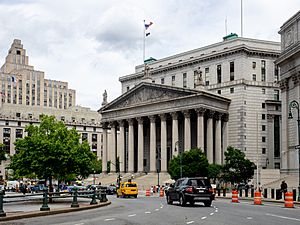
New York City has been a metropolitan municipality with a Strong mayor–council form of government since its consolidation in 1898. The city government is responsible for public education, correctional institutions, public safety, recreational facilities, sanitation, water supply, and welfare services.
The City Council is a unicameral body of 51 council members whose districts are defined by geographic population boundaries. Each term for the mayor and council members lasts four years and has a two consecutive-term limit, which is reset after a four-year break. The New York City Administrative Code, the New York City Rules, and the City Record are the code of local laws, compilation of regulations, and official journal, respectively.
Each borough is coextensive with a judicial district of the state Unified Court System, of which the Criminal Court and the Civil Court are the local courts, while the New York Supreme Court conducts major trials and appeals. Manhattan hosts the First Department of the Supreme Court, Appellate Division while Brooklyn hosts the Second Department. There are several extrajudicial administrative courts, which are executive agencies and not part of the state Unified Court System.
New York is divided between, and is host to the main branches of, two different U.S. district courts: the District Court for the Southern District of New York, whose main courthouse is on Foley Square near City Hall in Manhattan and whose jurisdiction includes Manhattan and the Bronx; and the District Court for the Eastern District of New York, whose main courthouse is in Brooklyn and whose jurisdiction includes Brooklyn, Queens, and Staten Island. The U.S. Court of Appeals for the Second Circuit and U.S. Court of International Trade are based in New York, also on Foley Square in Manhattan.
Interesting facts about New York City
- New York was named in honor of the Duke of York (later King James II of England).
- New York City is sometimes referred to as the Five Boroughs.
- The city is the most densely populated major city in the United States (2022).
- NYC has more than double the population of Los Angeles.
- As many as 800 languages are spoken in New York.
- The New York area is home to a distinctive regional accent called the New York dialect, alternatively known as Brooklynese or New Yorkese. It has been considered one of the most recognizable accents within American English.
- New York Fashion Week (NYFW) is a high-profile semiannual event featuring models displaying the latest wardrobes created by prominent fashion designers. NYFW sets the tone for the global fashion industry.
- New York City hosted the 1984 Summer Paralympics and the 1998 Goodwill Games.
- Four of the ten most expensive stadiums ever built worldwide (MetLife Stadium, the new Yankee Stadium, Madison Square Garden, and Citi Field) are in the New York metropolitan area.
- The New York City Marathon, which courses through all five boroughs, is the world's largest running marathon.
- Mass transit in New York City, most of which runs 24 hours a day, accounts for one in every three users of mass transit in the United States.
- Two-thirds of the nation's rail riders live in the New York City metropolitan area.
- The annual Macy's Thanksgiving Day Parade is the world's largest parade, beginning alongside Central Park and proceeding southward to the flagship Macy's Herald Square store; the parade is viewed on telecasts worldwide and draws millions of spectators in person.
Notable people
Images for kids
-
Columbia University was founded by royal charter in 1754 under the name of King's College.
-
The current five boroughs of Greater New York as they appeared in 1814. The Bronx was in Westchester County, Queens County included modern Nassau County, Kings County had six towns, one of which was Brooklyn, and New York City is shown by hatching in southern New York County on the island of Manhattan, and Richmond County on Staten Island.
-
The core of the New York City metropolitan area, with Manhattan Island at its center
-
Lower and Midtown Manhattan, as seen by a SkySat satellite in 2017
-
Central Park in Winter by Raymond Speers, in Munsey's Magazine, February 1900
-
Looking down Broadway in Midtown Manhattan. New York City had an estimated population density of 29,302.37 inhabitants per square mile (11,313.71/km2) in 2020, as the most densely populated major U.S. city. Manhattan (New York County) alone was home to 74,870.7 inhabitants per square mile (28,907.7/km2), rendering it the most densely populated municipality in the United States.
-
The Spanish Harlem Orchestra. New York City is home to nearly 3 million Latino Americans, the largest Hispanic population of any city outside Latin America and Spain.
-
The Financial District of Lower Manhattan including Wall Street, the world's principal financial center
-
The Stephen A. Schwarzman Headquarters Building of the New York Public Library, at 5th Avenue and 42nd Street
-
The Metropolitan Museum of Art, part of Museum Mile, is one of the largest museums in the world.
-
The growing skyline of Long Island City, Queens (background), facing the East River and Manhattan in May 2017
-
The Grand Concourse in the Bronx, foreground, with Manhattan in the background in February 2018
-
St. George, Staten Island as seen from the Staten Island Ferry, the world's busiest passenger-only ferry system, shuttling passengers between Manhattan and Staten Island
See also
 In Spanish: Nueva York para niños
In Spanish: Nueva York para niños


